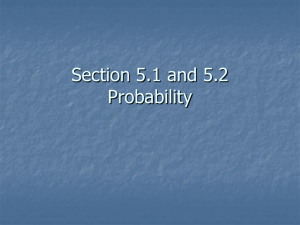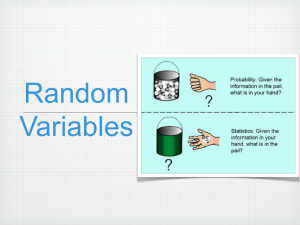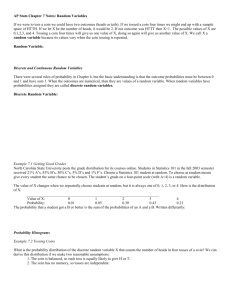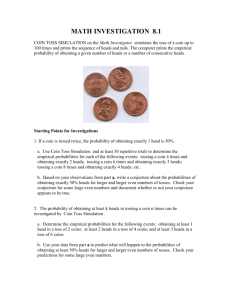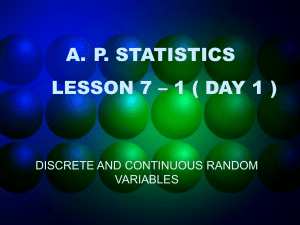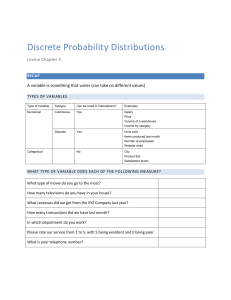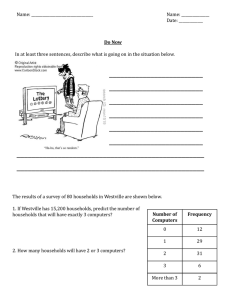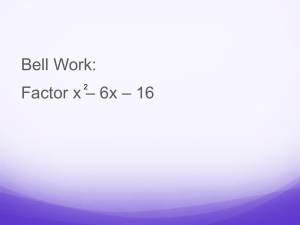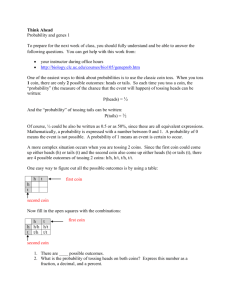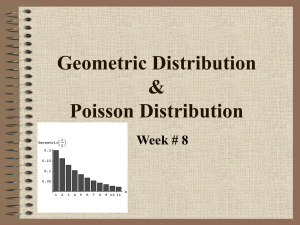Random Variable and Its Probability Distribution. Part I
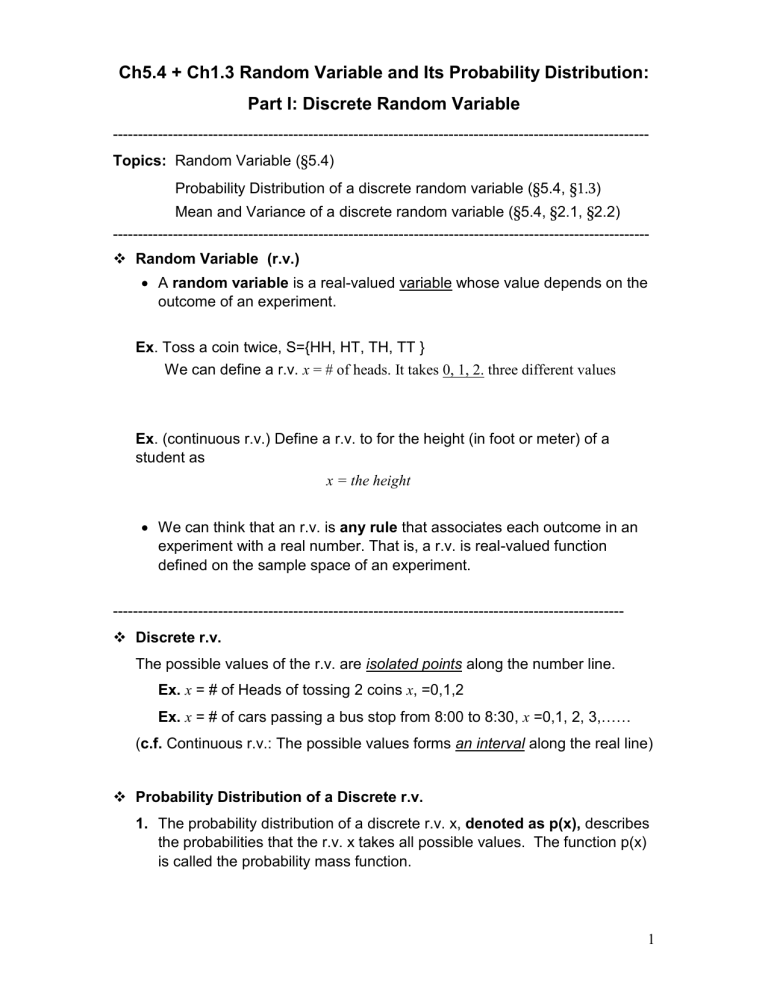
Ch5.4 + Ch1.3 Random Variable and Its Probability Distribution:
Part I: Discrete Random Variable
-----------------------------------------------------------------------------------------------------------
Topics: Random Variable ( § 5.4)
Probability Distribution of a discrete random variable ( § 5.4, §1.3
)
Mean and Variance of a discrete random variable ( § 5.4, § 2.1, § 2.2)
-----------------------------------------------------------------------------------------------------------
Random Variable (r.v.)
A random variable is a real-valued variable whose value depends on the outcome of an experiment.
Ex . Toss a coin twice, S={HH, HT, TH, TT }
We can define a r.v. x = # of heads. It takes 0, 1, 2. three different values
Ex . (continuous r.v.) Define a r.v. to for the height (in foot or meter) of a student as x = the height
We can think that an r.v. is any rule that associates each outcome in an experiment with a real number. That is, a r.v. is real-valued function defined on the sample space of an experiment.
------------------------------------------------------------------------------------------------------
Discrete r.v.
The possible values of the r.v. are isolated points along the number line.
Ex.
x = # of Heads of tossing 2 coins x , =0,1,2
Ex.
x = # of cars passing a bus stop from 8:00 to 8:30, x =0,1, 2, 3, ……
( c.f.
Continuous r.v.: The possible values forms an interval along the real line)
Probability Distribution of a Discrete r.v.
1. The probability distribution of a discrete r.v. x, denoted as p(x), describes the probabilities that the r.v. x takes all possible values. The function p(x) is called the probability mass function.
1
Ex.
x = # of head in tossing a fair coin. Then the probability distribution of x is
P(0) = P[x=0] = P[T] = 0.5
P(1) = P[x=1] = P[H] = 0.5
Ex.
x = result of tossing a fair dice. The probability distribution of x is
P(1) = P(2) = P(3) = P(4) = P(5) = P(6) = 1/6
2.
In general, the probability that x gets a value c, P( x=c ), is defined as the sum of all corresponding outcomes in S (i.e., the sample space) that are assigned to the value x.
Ex.
x = # of heads in tossing 2 fair coins.
P (0)
P (1)
0
( )
( ) ( )
0.5*0.5
0.25
(
TH )
P HT )
P TH )
0.5
P (2)
2
( )
( ) ( )
0.5*0.5
0.25
3. There are 3 ways to display a probability distribution for a discrete r.v.:
(1) through a density plot
(2) through a table
(3) through a formula
Ex. Toss a coin 3 times, and let x = # of heads. Then the probability distribution of x is:
3!
x !(3
x )!
x
0.5 0.5
3
x
3!
x !(3
x )!
0.5
3
0.125
x
3!
!(3
x )!
, x
0,1, 2,3
(1) Density plot
2
If we convert the density plot in (1) we got:
(2) Table x
P( x )
0
0.1
1
0.4
2
0.3
3
0.2
(3) Formula
Such as the one we gave for x = # of heads from tossing a coin 3 times.
From the probability distribution given in (2) , we can calculate
P( x = 3 ) = 0.2
P( x < 2 ) = P(x=0) + P(x=1) = 0.1 + 0.4 = 0.5
P( x
2 ) = P(x<2) + P(x=2) = 0.5 + 0.3 = 0.8.
P( x > 0 ) = 1 – P(x=0) = 1 – 0.1 = 0.9.
4. For any probability distribution P( x ), (recall the axiom of probabilities…)
(1) 0
( )
1
(2)
x
Ex.
(1) Find the value of c so that the following function is a probability distribution of a r.v. x :
where x
0,1,2,3
P(0)+P(1)+P(2)+P(3)=1 (Note that x can only take 0, 1, 2, 3)
2c+3c+4c+5c=1, so c=1/14.
(2) For this probability distribution, find P( x
2)
P( x
2) =P(x=0) + P(x=1) + P(x=2) = 2c+3c + 4c = 9c = 9/14
Alternatively, P( x
2) = 1- P(x>2) = 1- P(x=3) = 1- 5c = 1- 5/14=9/14.
3
Mean and Variance of a discrete r.v. with probability distribution
The mean
x
x
(The mean of a r.v. is also called as the expected value.
)
The variances
x
2 x
x
x
2 x x
2 x
2
The standard deviation
=
2 x
Ex. Toss a coin twice, x = # of heads. Find
x
and
2 x
.
The probability distribution is x
P( x )
0
0.25
1
0.5
2
0.25
x
x
0 0.25 1 0.5 2 0.25 1 (the number of heads we can expect to get if we toss a coin twice).
x
2 x x
2
2 x
0
2
0.5
.
Ex. A contractor is required by a county planning department to submit from 1 to 5 different forms, depending on the nature of the project. Let x = # of forms required of the next contractor, and p
kx for x=1,2,3,4,5.
(a) What is the value of k?
From the form of P(x), we have
P (1)
P (2)
P (3)
P (4)
P (5)
1 (Note x can only take 1, 2, 3, 4, 5)
That is, 1k + 2k + 3k + 4k + 5k = 1. So k = 1/15 (since P(x) = x/15 are between 0 and
4
1 for x = 1, 2, 3, 4, 5 and they sum to 1, k=1/15 is a valid solution.
(b) What is the probability that at most 3 forms are required?
P(x
3) = p(x=1) + P(x=2)+P(x=3) = 1k + 2k + 3k = 6k = 6/15 = 2/5
(c) What is the expected number (i.e., mean) of forms required ?
1P(1) + 2P(2)+3P(3)+4P(4)+5P(5) = 1k + 2*2k + 3*3k + 4*4k+ 5*5k = 55k = x
55/15=3.67
(d) What is the SD of the number of forms required?
x
2
( )
2 x
1
3 k
2
3 k
3
3 k
4
3 k
5
3 k
3.67
2
225 k
3.67
2 2
1.53
x
x
2
5



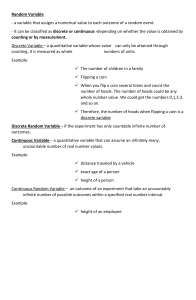
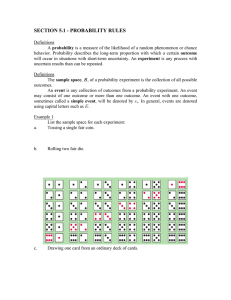
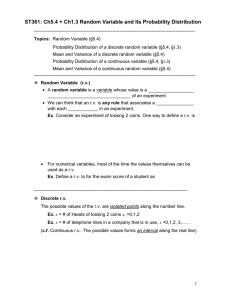
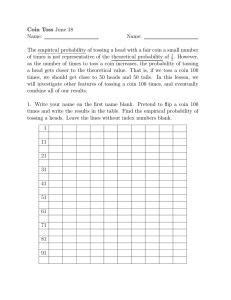

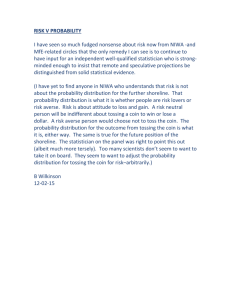
![2*V[X]=1/n2*np(1-p)=p(1-p)/n 1833.0 5.05.0 !8!6 !14 )6 ( = = = XP](http://s3.studylib.net/store/data/008711824_1-0d6d751ef61e41cbf10ab5a47ea15653-300x300.png)
